Oceanographic instrument development, a first step to exploring the unexplored
Written by: Kalina C. Grabb
Putting the exploration in oceanography
The ocean remains largely unexplored. NOAA and National Geographic state that 80% of the ocean floor remains “unmapped, unobserved, and unexplored.” This is a decrease from just two decades ago, when 95% of the ocean was unexplored. While this appears like a lot of progress, it is a bit deceiving. There is much more to the ocean than just the seafloor. The ocean is a three-dimensional ecosystem that has many complex and intricate bio-geo-chemical interactions with large implications on our planet and humanity. As humans, we also produce large stressors that have altered the natural processes of the ocean, making it even more important to study these interactions within the ocean.
As oceanographers, we strive to understand how the ocean functions. In order to study the many minute processes that are yet to be understood, we frequently find ourselves doing something that has not been done before. At times, we get lucky and some hints may be able to be gleaned from similar previous studies with a different purpose – for example, we can turn to the medical field to learn more about the chemical cycling that we study within the oceans. In other instances, there is no precedented work done on the subject. Exploring the extreme conditions of the ocean requires adaptation and innovation. The field of oceanography is constantly inventing new ways to measure processes, adapting methods and instruments to marine environments, and exploring ocean dynamics in unprecedented ways.
There remains much more of the ocean to explore beyond the seafloor, but all efforts can make some difference. With the oceans covering over 70% of this planet, it is vital to prioritize oceanographic studies in order to understand our place on this planet and preserve the inhabitance of it.
The exploration within a PhD
I am lucky that my PhD research is focused on the design and development of a novel submersible instrument. We have designed the first submersible instrument that can measure superoxide within shallow water aquatic environments. Superoxide (O2•-) is a reactive oxygen species (ROS), which are oxygen radicals that are created when molecular oxygen gains elections. ROS are produced and consumed by all organisms that utilize oxygen. Inside of us, ROS can build up and lead to cancer, heart disease, auto immune disorders, and many other health conditions. This is why we are encouraged to eat antioxidants, such as blueberries. Antioxidants break down ROS and can help regulate their abundance. More recently, scientists are realizing that they can also be beneficial to organism health by playing a role processes such as cell communication, growth stimulation, and pathogen protection. Despite these vital roles, ROS are not well understood.
Why do we want to measure superoxide underwater, you may ask? One shallow water ecosystem that we are particularly interested in understanding what the purpose of ROS is, is within coral reefs. A few years back, scientists within our lab discovered that corals are associated with levels of superoxide that are orders of magnitude higher than most other marine organisms. Superoxide appears to be important to coral health, however, there were no other measurements of superoxide associated with coral within their natural environment. One major road block to understanding ROS dynamics in marine systems is the difficulty to measure them in situ, meaning in the natural environment where they are produced. For superoxide, this is extremely important because it is very reactive and only exists for a few minutes, at most. Traditionally, superoxide has only been able to be measured in the laboratory through a bench top system. However, my PhD advisors, Colleen Hansel and Scott Wankel, wanted to be able to make measurements of superoxide in situ, close to the area of production. They hoped to target marine environments such as coral reefs, algal blooms, and deep-sea processes. Therefore, they came up with the idea of making a submersible instrument to measure superoxide. Most importantly, they also came up with a catchy acronym to name the instrument: DISCO, which stands for DIver-Operated Submersible Chemiluminescent sensOr.
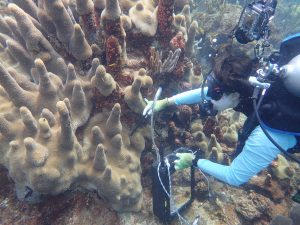
Kalina Grabb using DISCO in the US Virgin Islands to measure superoxide associated with coral. Picture credit Cynthia Becker.
The idea for a new instrument was only the beginning of a long, multi-year road of development, testing, and redesigning. Once the scientists think of the idea, we have to convey this idea and work closely with the engineers, who take the lead in designing and building the instrument. For this project, Scott and Colleen pitched the idea to engineer Jason Kapit, who willingly agreed to take the lead with prior assistance from Kevin Manganini and current assistance from William Pardis. For us, we are very lucky to work at Woods Hole Oceanographic Institution (WHOI). Here at WHOI, we have in-house engineers that work just minutes away from us. There are machine shops, dunk tanks, pressure testing tanks, cold rooms, and most importantly, scientists and engineers that have a lifetime of experience developing oceanographic instruments. There is also the historical knowledge of the institution; there are generations of oceanographers and engineers before us that have been sending instruments to the seafloor for decades. The engineers and facilities here at WHOI make instrument development accessible scientists with an idea.
For exploration, a team is necessary
After working on this project for a few years, it became clear to me that instrument development for chemical oceanography can only succeed through collaboration. Our team consists of a lab group of chemical oceanographers (2 scientists, 2 PhD students, and others to support) and ocean engineers (1 lead engineer, 1 assistant engineer, and many others who work behind the scenes to machine, design, and test parts). The steps in instrumentation are slow, deliberate, and collaborative. The design of the instrument is talked through by both parties. Scientists explain the necessary attributes and ideal functionality of the instrument, engineers provide reality checks for what is possible and practical. The engineers produce a prototype, testing the functionality of the instrument. We then test the chemistry and use the instrument to see if we can discover any hidden bugs or any necessary engineering improvements. This iterative process requires us to work together and push the instrument to its limits from the perspective of our respective disciplines. By working on the instrument together, slowly, I have started to pick up on the engineering lingo and learn the way engineers approach problems; methodically and deliberately. This has come in handy both for creating the instrument and for testing in the field – more on this to come.
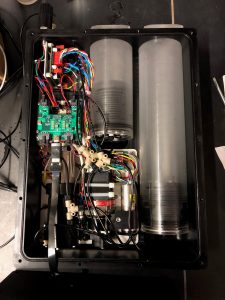
Inside of DISCO
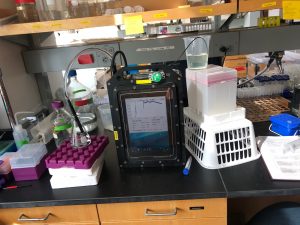
DISCO during bench top testing.
For DISCO, the approach was to take the chemistry and main components of the bench top system and redesign it for submersible use. As always, this is not as easy as it sounds! While the internal components were very similar, on the bench, the fluidic pumps, power source, and computer were external to the instrument. All of these components would have to be contained within a submersible housing, and a reasonably sized one at that. For our instrument, the biggest challenge has been finding miniature pumps that can pump water precisely and reliably, but not draw too much power or clog under water. Another challenge is the chemistry – In finding new components to use, the engineers have to work only with inert materials that will not react with ROS. Needless to say, this has been no small task, but over the last three years we have successfully built two instruments that measure superoxide in situ: DISCO for shallow water analysis and SOLARIS (Submersible Oceanic Luminescence Analyzer of Reactive Intermediate Species) for deep sea measurements.
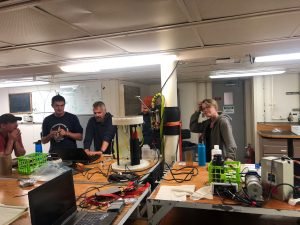
Part of the team troubleshooting during bench top testing with SOLARIS in the center. From left to right: William Pardis (Engineer), Scott Wankel (scientist), Jason Kapit (Engineer), Colleen Hansel (Scientist).
Once an instrument is built, we have to tackle a whole new challenge – testing it in the field. On a recent cruise aboard the R/V Atlantis, we were lucky enough to have the whole team present at sea to test SOLARIS. SOLARIS is a deep sea instrument that measures superoxide in situ and is the main focus for our most recent PhD student, Lina Taenzer. While we could use the technology of DISCO as a stepping stone, SOLARIS brought its own suite of challenges since it had to be able to withstand the immense pressure of the deep sea and also be operated from either within a submersible or through a wire to the ship. On the cruise, we were very lucky to have access to the Human Occupied Vehicle (HOV), Alvin, which is a submersible that can take one pilot and two scientists to the seafloor (max 4500 meters). The scientists inside Alvin can control SOLARIS, which is mounted outside Alvin on the basket and operated using the manipulators. Each day, we would deploy SOLARIS either on Alvin or the conductivity, temperature, and depth (CTD) carousel, which is attached to the boat via a wire and allows for remote operation of the instrument as it profiles the water column. During use, we would test all the functions of the instrument, taking note of the changes in chemical signal to assess what is a “real” signal and what is artifact of our instrument. Post deployment, we would run bench top tests for calibration and to ensure that the instrument was accurately measuring what we intended it to. These tests were run daily, allowing us to quickly identify if there was a problem in the instrument, which is not as easy as it sounds. When you are making the first ever in situ superoxide measurements of the deep sea, it is very hard to disentangle instrument variation from natural variation. There is no previous data to compare to. With both the engineers and scientists on board, we were able to tweak aspects of instrument, improving the software interface to cater to user needs and ensuring there were no leaks, no clogs, reliable pumping rates, and no contamination. The term “troubleshooting” began to mean something new to me: methodical investigation of each aspect of the instrument to isolate any problem that may be contributing to the overall measurement. We as scientists learned more about the intricacies of the engineering aspects, and the engineers became more acquainted with the nuances of the science. This crossover is a powerful bond that is not easy to obtain. Over the course of the three week cruise, we successfully confirmed that we were able to make accurate measurements of superoxide in situ in the deep sea – for the first time ever! We were even able to show that deep sea coral are associated with high concentrations of superoxide. It was previously unknown if deep sea coral even produce superoxide!
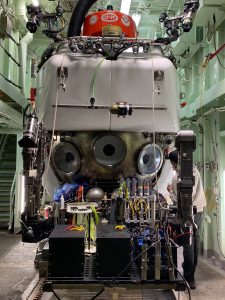
SOLARIS mounted for deployment on Alvin
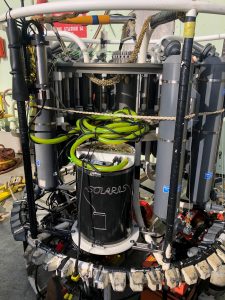
The CTD carousel
It is a huge success to have an instrument work on the first field endeavor. This was only possible thanks to this incredible team that has been working together for years on this iterative process. We are able to use what we had learned during DISCO development and implement it into the deep sea version, SOLARIS. We are able to use the mutual understanding of each other’s fields to brainstorm, troubleshoot, and interface with the instrument as one cohesive team. We were also able to go back and forth and work together at WHOI prior to the cruise, visiting each other’s labs for testing and meeting on a regular basis. On the cruise, we were able to troubleshoot daily and immediately identify and fix any issues that arose. Only with our entire team and the support of other scientists, engineers, and resources within our lab and at WHOI, were we able to make this possible. I am very grateful to be part of such a collaborative endeavor with scientists and engineers that continues to push beyond the existing knowledge of chemical oceanography and ocean engineering.
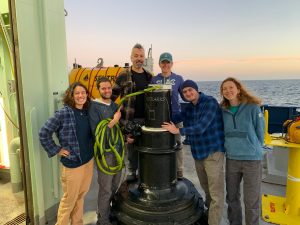
SOLARIS team posing with SOLARIS aboard the R/V Atlantis. From left to right: Kalina Grabb (Scientist), Jason Kapit (Engineer), Scott Wankel (Scientist), Colleen Hansel (Scientist), William Pardis (Engineer), Lina Taenzer (Scientist).
The development of both DISCO and SOLARIS continues to be on-going with improvements that focus on them being more compact and user-friendly. These instruments also have the capability to being adapted to measure other reactive chemicals in addition to superoxide. The endless possibilities of data that are now able to be collected using DISCO and SOLARIS has redefined the term “unexplored” – ROS are known to play a role in many chemical processes that remain poorly constrained, however, ROS may also influence other reactions that are yet to be determined. We cannot always know what remains to be explored until we have discovered it. While it is only a tiny sliver of unexplored territory in the realm of the oceans as a whole, DISCO and SOLARIS have now opened up new avenues to further explore the intricacies of the ocean.